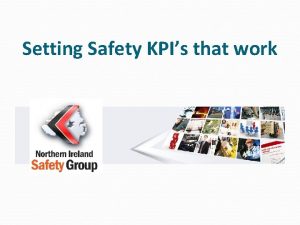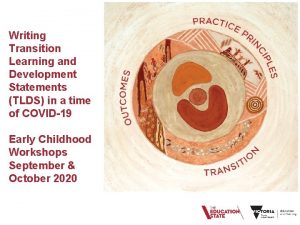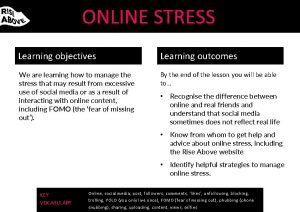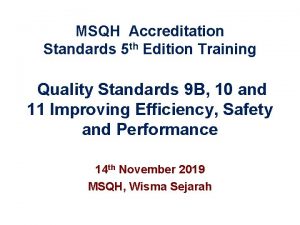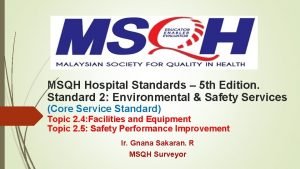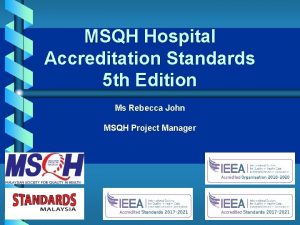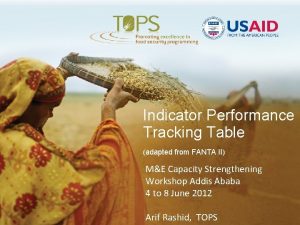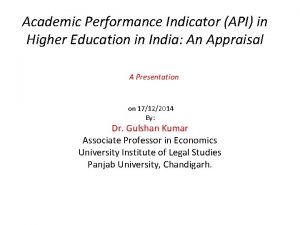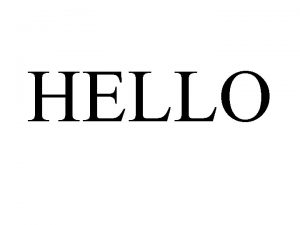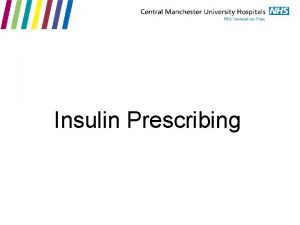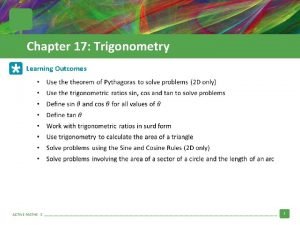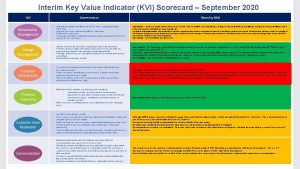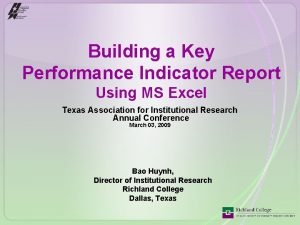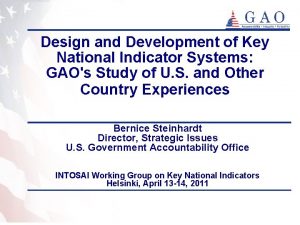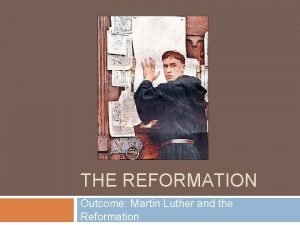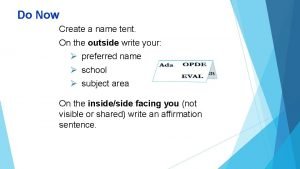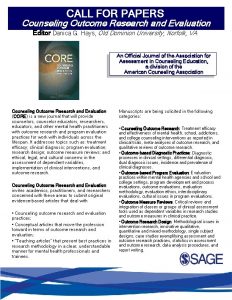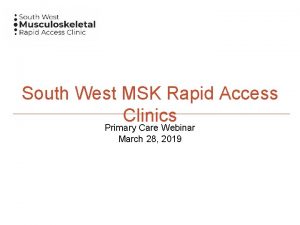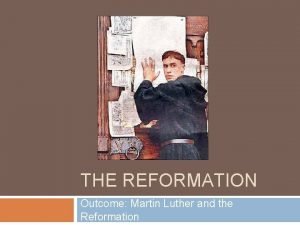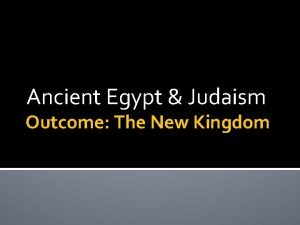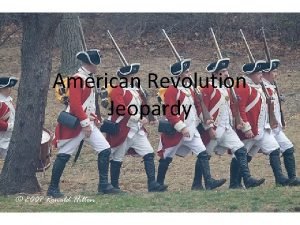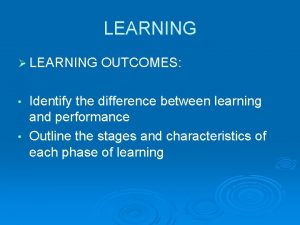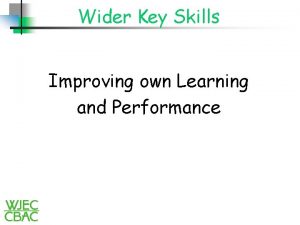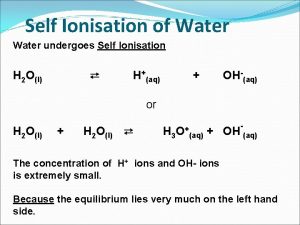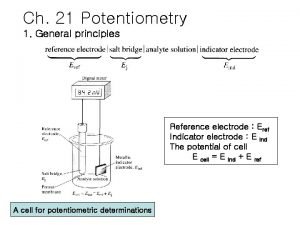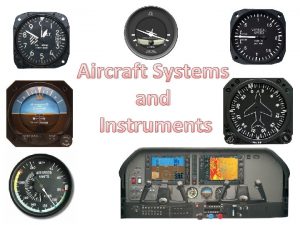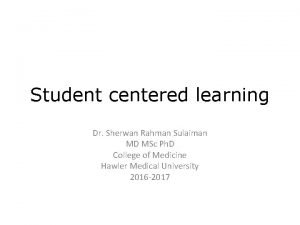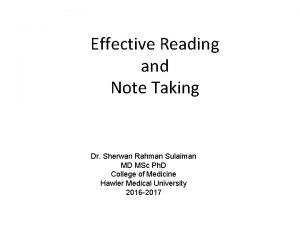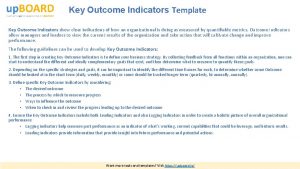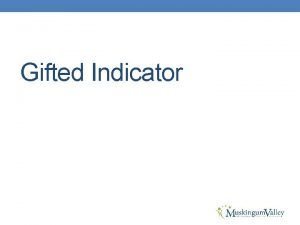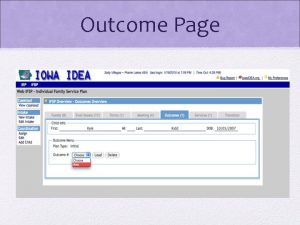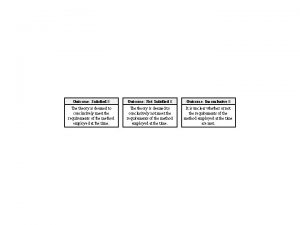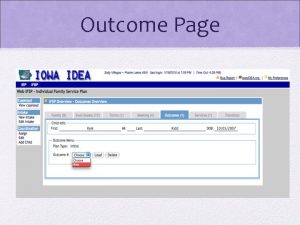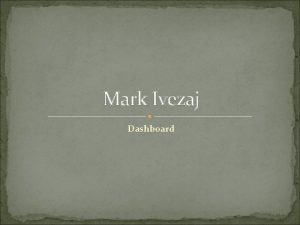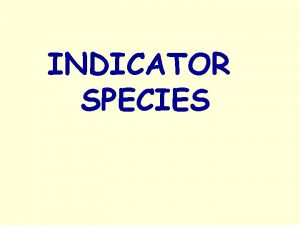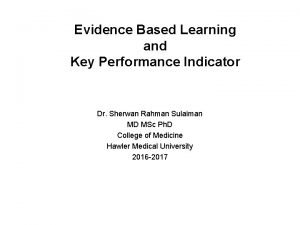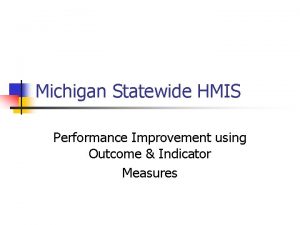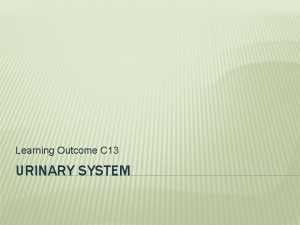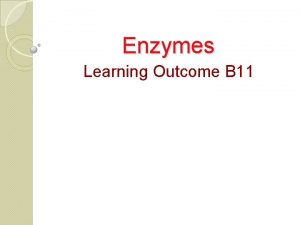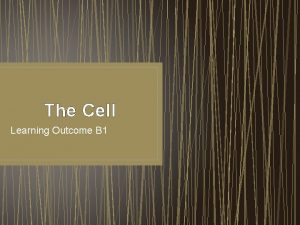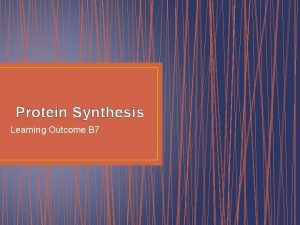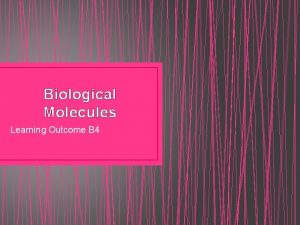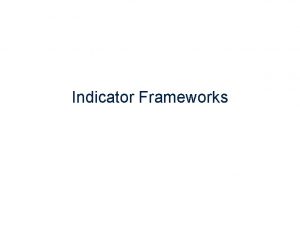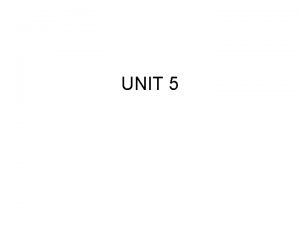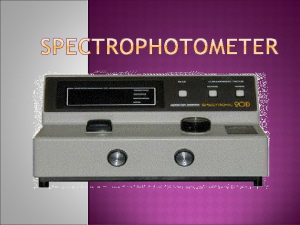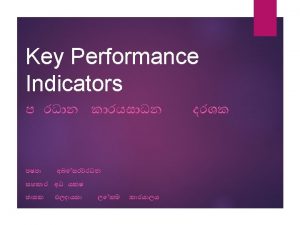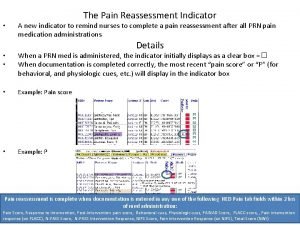Learning Outcome and Key Performance Indicator Dr Sherwan











































- Slides: 43

Learning Outcome and Key Performance Indicator Dr. Sherwan Rahman Sulaiman MD MSc Ph. D College of Medicine Hawler Medical University 2016 -2017

Workshop’s Learning Outcomes (LOs) Attendees at the end of this workshop will be able to: 1. Comprehend the nature and role of Program and Course learning outcomes in instruction. 2. Align an understanding relationships between Teaching Methods, Assessments Methods and LOs, 3. Write learning outcomes using the correct format. 4. Summarize the role of learning outcomes in instruction and assessment.

Key Performance Indicators: Why? Performance of a higher education institution & its Programs is complex (teaching, research, community…) KPIs summarize performance in key areas scientifically, rationally, and meaningfully for different stakeholders: 1. Faculty & Staff 2. Students 3. External agencies (NCAAA, NCAAA employers, …)

What are KPIs? ? ? … KPIs = Key Performance Indicators …a measure of performance or achievement …a Key Success Indicator (KSI) …a measure of results and efficiency Quantifiable performance measures used to define success and measure progress toward the achievement of goals. (maybe qualitative via rubrics)

KPI KEY is fundamentally important to gain advantage; a make-or-break component for success. Performance when outcomes can be clearly measured, quantified, and easily influenced by the institution or Program. Indicator provides leading information on future performance. (ie. , when the gas gauge is on “E” then the leading information tells us that the car’s future performance will be to stop; so the action plan is to get gas immediately)

NCAAA Learning & Teaching KPIs 5. Ratio of students to teaching staff (Based on full time equivalents) 6. Students overall rating on the quality of their courses. (Average rating of students on a five point scale on overall evaluation of courses. ) 7. Proportion of teaching staff with verified doctoral qualifications. 8. Percentage of students entering Programs who successfully complete first year. 9. Proportion of students entering undergraduate Programs who complete those Programs in minimum time. 10. Proportion of students entering post graduate Programs who complete those Programs in specified time. 11. Proportion of graduates from undergraduate Programs who within six months of graduation are: employed, enrolled in further study, not seeking employment or further study

Goals and Objectives Strategic Goal 1: To enhance and expand Program facilities and infrastructure for research activities. Major Strategies S 1. Establish infrastructure for research. S 2. Encourage collaborative research among faculty. S 3. Provide appropriate Objective 1: (70 %) of funding for research and the Program faculty creative activities conducting research or are S 4. Expand facilities for involve in related by the research end of 2014. Objective 2: ? ? ? Strategic Goal 2: Objective 1: Objective 2: Strategic Goal 3: Objective 1: Objective 2: Quality Goal 1: Objective 2: Measurable Indicators KPI 1: Percentage of established research quality standards KPI 2: Number of publications (#/yr) in international reviewed journals KPI 3: Number of organized scientific/Research events (workshops / seminars & conferences) Analysis What do the findings mean? How are they applied? HOW?

Introduction • The Design phase of a typical curriculum development process (Analysis, Design, Development, Implementation, Evaluation) is largely concerned with developing clearning objectives and learning outcomes. • It is important to recognize during this phase that there is a direct relationship between objectives, learning outcomes, teaching strategy / methods & students assessments (Rubrics – KPIs with benchmarking and analysis).

Theory Into Practice 5 Questions for Instructional Design 1. What do you want the student to be able to do? (Outcome) 2. What does the student need to know in order to do this well? (Curriculum) 3. What activity will facilitate the learning? (Pedagogy—learning & teaching) 4. How will the student demonstrate the learning? (Assessment) 5. How will the teacher know the student has done this well? (Criteria)

Learning Outcome are: • Learning outcomes: describe what learners are supposed to know, know understand, understand or are able to do at the end of the Program or course. • LOs are based upon: • the needs of the learner (individual & personal). • the needs of society (mission statements). • what the learner should know about a particular subject in order to perform successfully (career and personal lifestyle).

LOs are: • What a STUDENT should learn as a result of a period of specified and supported study. • The ACHIEVEMENTS of the learner rather then the intentions of the teacher. • Focus is directly on Student Performance.

LOs are: Formal statements that articulate: articulate • What students know and are able to do after instruction • Why students need to do this -relevancy

LOs are: Are concerned with the learning of the student: STUDENT… PERFORMANCE and ACHIEVEMENT Ø Ø What the student CAN DO What the student KNOWS AND CAN DO What the student UNDERSTANDS OR COMPREHENDS and CAN DO Must be measurable or observable

Objectives vs. LOs • The distinction between learning outcomes and learning objectives is not universally recognized. • Many instructors may find that the term “learning outcomes” describes what they have already understood by the term “learning objectives. ” What is the difference?

For NCAAA the difference between course LOs and objectives… • Learning objectives are statements of what the teacher intends for the students to learn and are generally part of a teacher-centered approach [are Mission, traditional, teacher or content driven]. • Learning outcomes are statements of what the student will KNOW and be able to DO or demonstrate as a result of their learning and are part of a student-centered approach.

Objectives vs. LOs • Learning objectives, objectives for example, may outline the material the INSTRUCTOR intends to cover in the course / Program or the disciplinary questions the class will address. Known as IN-PUTS. • By contrast, learning outcomes focus on what the STUDENTS know, comprehend and realistically are able to do… [skill performance] by the end of an assignment, activity, class, or course [achievement]. Known as OUT-PUTS.

Objectives vs. LOs • learning outcomes, mean focusing on the application and integration of the course content from the perspective of the student. • learning outcomes can more explicitly and directly address expectations for student learning.

Objectives ------- Outcomes Teacher-Centered Inputs Student-Centered Outputs Results Assessments Measurable Observable Content-Centered Traditional Performance & Achievement What else overlaps?

Writing Objectives & LOs Learning objectives can be written as teacher or curriculum centered content or they can be rewritten as student-centered learning outcomes The teacher will. . . will OR the student will…. Both learning objectives and outcomes must be measurable or observable. One assessment is for teaching and another assessment is for a student’s learning.

Examples • Example of a Learning Objective: Students will be taught the basic principles of database searching. [teacher will teach basic principles … ] • Example of a Learning Outcome: Students will be able to apply the principles of database searching in a review of literature. [student will KNOW and APPLY…]

Objectives or Outcomes? Which Dentist do you want working on your teeth? Student A: The teacher will instruct the student to know how to successfully drill cavities and repair teeth… Student B: The student earns 100% on the exam for drilling cavities and repairing teeth…. Student C: The student knows how and successfully drills out cavities and repairs teeth… Student D: The teacher successfully taught the student to drill out cavities and repair teeth.

Objectives or Outcomes? Which Pharmacist do you want filling your meds? Student A: The teacher will instruct the students to know how to successfully fill medical prescriptions… Student B: The student earns 100% on the exam for filling medical prescriptions…. Student C: The student knows how and successfully fills medical prescriptions… Student D: The teacher successfully taught the student to fill medical prescriptions….

Exercise • Please work as group in writing three learning objectives for your Program. • Now, re-write these objectives as LOs • Be prepared to share them and analyze the difference – they will be collected in order to be used latter.

The Importance of LOs 1. LOs build evidence for accountability, accountability accreditation, and for continuous improvement. § Show evidence of how well students learn. § Use evidence for continuous improvement and strategic plans.

The Importance of LOs 2. Know what you are doing… 3. Know why you are doing it… 4. Know what students are learning as a result; (key for assessment). 5. Make improvement changes based on results (research based improvements)

The Importance of LOs Shifting from: • Teachers teaching…. to students learning • Teaching effectiveness…. to learning results

Course learning outcomes serve the following purposes… • To inform students of what is expected of them. • To guide the teacher in his/her approach to delivery of content and assessment that focuses on what the student will be able to do as a result of the learning. • To influence the domain and level of learning required of the delivery and assessment. • To fulfill the requirements of one or more Program outcomes.

Learning Outcomes help… 1. Select learning content objectives and skills (What to teach? Teaching content priorities? ) 2. Development of instructional strategies that align with specific learning outcomes. 3. Develop and select instructional and Program materials that align with specific learning outcomes. 4. Construct evaluation instruments for assessing student performance based on the learning. outcomes. 5. Improve overall Program and as a faculty.

Benefits of Learning Outcomes 1. Learning outcomes measure & characterize the values that an institution, Program, or course have articulated for student development & performance. 2. A set of student learning outcomes define what students will know and be able to do when they have completed any degree, regardless of his/her major.

Benefits for Learning Outcomes 3. Student learning outcomes will help guide faculty across the university to develop curricula, plan courses, determine financial needs, design syllabi, construct learning activities, and assess student learning. 4. LOs provide a framework for learners and advisers in order to discuss the goals of the curriculum and the personal career goals for individual students.

Framework for L. O. Employment Needs Assessment Methods Teaching Strategy Teacher Objectives Student Needs Student Learning Outcomes Course Outcomes Institutional Mission Program Outcomes

Benefit: OBE “Outcome-Based Education” • Outcome-based education is a method of teaching that focuses on what students know and can actually do after they are taught. • All curriculum and teaching decisions are made based on how best to facilitate the desired outcome. • The desired outcome is selected first and the curriculum is created to support the intended outcome. • This leads to a planning process in reverse of traditional educational planning.

Where do L. O. come from? Learning Outcomes flows out from…… …the Mission Statement What must students do to demonstrate that the Institution and Program Mission Statements are accomplished?

Effects Program and Course Learning Outcomes Cause Mission Needs What will the student know and do in order to demonstrate the Mission is successfully achieved?

Where do L. O. come from? In addition to Knowledge & Cognitive Skills Domains, Learning Outcomes flows out from…… …student needs assessment … and employers needs (cause and effect chart)

Effects Learning Outcomes Cause Student Needs What will the student know and do in order to demonstrate student needs are successfully achieved?

Good LOs are… ü Usually written in the future tense ü Identify important learning requirements ü Are achievable ü Use clear language easily understandable to student When writing outcomes, it may be useful to use the following expression: “At the end of this Program or course the student should be able to……. ” Then follow with a verb. Useful verbs are: ? ? ?

Suggested Verbs Establish Provide Tabulate Schedule Audit Align Construct List Compile Demonstrate Draft Prepare Write Update Articulate Collect Generate Produce Document Develop Helpful? Need much more!!

Verbs Not To Use Consider Maintain Continue Ensure Understand Strengthen Encourage Maximize Reflect Review Enlarge Examine Explore Deepen Some of these verbs can be used if tied to specific actions or quantification Better? Yes… BUT!!

NQF Learning Outcome Verbs NQF Learning Domains Knowledge Cognitive Skills Interpersonal Skills & Responsibility Communication, Information Technology, Numerical Psychomotor Suggested Verbs list, name, record, define, label, outline, state, describe, recall, memorize, reproduce, recognize, record, tell, write estimate, explain, summarize, write, compare, contrast, diagram, subdivide, differentiate, criticize, calculate, analyze, compose, develop, create, prepare, reconstruct, reorganize, summarize, explain, predict, justify, rate, evaluate, plan, design, measure, judge, justify, interpret, appraise demonstrate, judge, choose, illustrate, modify, show, use, appraise, evaluate, justify, analyze, question, and write demonstrate, calculate, illustrate, interpret, research, question, operate, appraise, evaluate, assess, and criticize demonstrate, show, illustrate, perform, dramatize, employ, manipulate, operate, prepare, produce, draw, diagram, examine, construct, assemble, experiment, and reconstruct

Example of Program LOs ze y l a An is th At the time of receiving a BSN Degree, students: § Can identify, define, and solve problems; § Can locate and critically evaluate information; § Have mastered a body of knowledge and a mode of inquiry; § Can understand diverse philosophies and cultures within and across societies; § Can communicate effectively; § Can understand the role of creativity, innovation, discovery, and expression across disciplines; and § Have acquired skills for effective citizenship and life-long learning. What is the major problem with this list? ?

Specific Program LOs (Dentistry Examples) 1. 2. Graduates should demonstrate sound knowledge of the following areas as they relate to the practice of dentistry (includes a list of over 20 specific dentistry content areas). Graduates must have the ability to apply their knowledge and understanding of relevant principles and theories in carrying out the following types of responsibilities (e. g. problem recognition for disease identification and diagnosis, problem solving in dental care, critical thinking of dental research, patient investigation—biopsy techniques, radiography, treatment plans). Write 3 specific Program LOs for your Program by using the generic Program LOs shown on the previous slide. (present to group using flip chart + Analyze)

Question
 Safety kpis
Safety kpis Kpis template
Kpis template Veyldf learning and development outcome descriptors
Veyldf learning and development outcome descriptors Learning objectives examples
Learning objectives examples Msqh performance indicator
Msqh performance indicator Msqh meaning
Msqh meaning Msqh standard 7
Msqh standard 7 Indicator performance tracking table
Indicator performance tracking table Star situation task action result
Star situation task action result Ged high impact indicators
Ged high impact indicators Academic performance indicators
Academic performance indicators Learning outcomes generator
Learning outcomes generator Poem learning objectives
Poem learning objectives Learning outcomes prescribes
Learning outcomes prescribes Learning outcome
Learning outcome Learning outcomes examples
Learning outcomes examples Key value indicator
Key value indicator Key indicator report
Key indicator report Key national indicator system
Key national indicator system Cuadro comparativo e-learning m-learning b-learning
Cuadro comparativo e-learning m-learning b-learning Key partners bmc example
Key partners bmc example Key partners key activities key resources
Key partners key activities key resources The reformation outcome martin luther and the reformation
The reformation outcome martin luther and the reformation Ipegs examples
Ipegs examples Counseling outcome research and evaluation
Counseling outcome research and evaluation The age of exploration outcome china and japan's reactions
The age of exploration outcome china and japan's reactions Japan during the age of exploration
Japan during the age of exploration Rapid access clinic london ontario
Rapid access clinic london ontario The reformation outcome martin luther and the reformation
The reformation outcome martin luther and the reformation Ancient egypt and judaism outcome the new kingdom
Ancient egypt and judaism outcome the new kingdom Lexington and concord outcome
Lexington and concord outcome Difference between learning and performance
Difference between learning and performance Improving own learning and performance examples
Improving own learning and performance examples Bars rating scale
Bars rating scale Disadvantages of bell curve in performance appraisal
Disadvantages of bell curve in performance appraisal Jcids process
Jcids process Strong base weak base
Strong base weak base Self ionization of water equation
Self ionization of water equation Principle of potentiometry
Principle of potentiometry Atomatoflames
Atomatoflames Strong acid weak base titration
Strong acid weak base titration Inductive and analytical learning in machine learning
Inductive and analytical learning in machine learning Inductive learning
Inductive learning Eager learner vs lazy learner
Eager learner vs lazy learner
